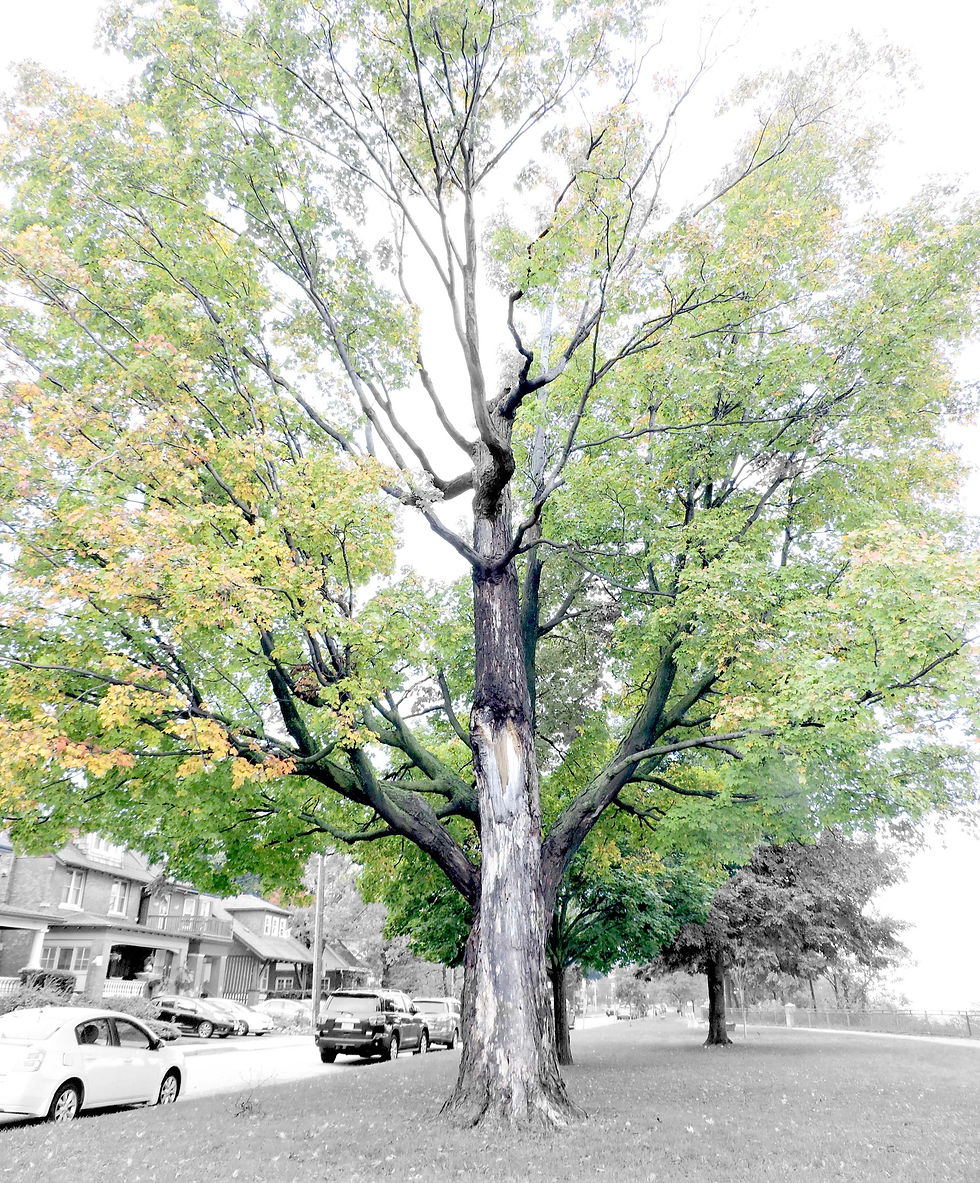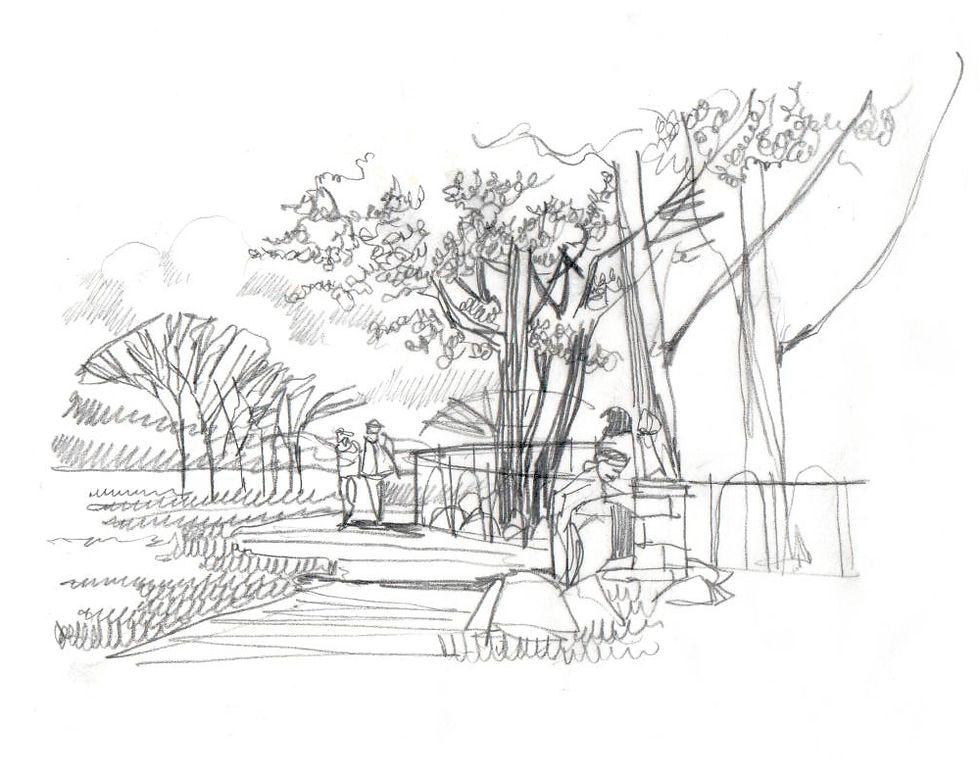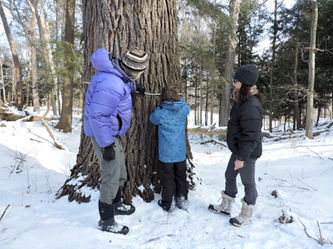
Monument Tree Database
Natural Systems Research

Monument Tree

Tree Family

Canopy Cover

Network
A New Approach to Conservation
Purpose
Building Conservation Networks
Environmental Artwork & Ecological Restoration
Hamilton


Restoring the World's Ecosystems
Building Conservation Networks is a research-based installation project created by Lesia Mokrycke to raise awareness about the degradation of the urban forest, to illuminate relationships between water and terrestrial ecosystems, and to connect living trees with human experience. The project underscores the key message that protecting ancient trees in urban areas and restoring habitat can significantly decrease carbon emissions and safeguard the planet.
This creative urban design and public art project identifies historic, monumental trees as key anchors in the ecological and cultural life of the city. Landmark, Monument trees contain information that give us clues about times past and can foster stronger and more resilient urban forests.
Our work to raise awareness and restore critical ecosystems aligns with the goals of the UN Decade on Ecosystem Restoration to prevent, halt and reverse the degradation of ecosystems on every continent and in every ocean. Led by the United Nations Environment Programme (UNEP) and the Food and Agricultural Organization (FAO), this UN Decade's mission is to ramp up restoration and put the planet's ecosystems on track to build a sustainable future.
As a core partner, Tropos focuses on four key areas of the UN Decade on Ecosystem Restoration: Forests, Urban Areas and Freshwater. That means that every Monument Tree protected, new tree planted, and local property restored through our work contributes to this global effort to revive ecosystems worldwide.

World Class Design
Art
Restoration
Building Conservation Networks
How ancient, urban trees support the future of cities
Protecting Ancient Trees
The Monument Tree Project, led by Tropos, is a long-term research and public engagement initiative that brings ecological memory to the forefront of urban planning. Situated in Hamilton, Ontario—a region once characterized by expansive oak savanna and Carolinian forest—the project maps and documents the city’s oldest native trees, known as Monument Trees.
Monument Trees are living landmarks: over 150 years old, these trees are monumental in age and size and also in their ecological function and cultural significance. Through Tropos’ research, more than 1,500 of these trees have been identified and mapped across the city, surfacing an ecological network embedded within Hamilton’s urban fabric.
By highlighting the significance of these trees—and the stories of the people who live with them—Monument Trees builds a bridge between historical landscape patterns and contemporary urban life. The project encourages a re-evaluation of urban planning and conservation strategies and advocates for the integration of these natural monuments into the city's ecological infrastructure. It invites a new model of conservation grounded in memory and community, where legacy trees are not only preserved but actively integrated into a future vision of urban conservation.

Strategic Conservation
Each Ward contains a unique number of Monument Trees—rare, living remnants of pre-settlement landscapes that are 150 years or older. These trees are much more than historic landmarks; they play an outsized role in urban climate resilience. Thanks to their size and age, Monument Trees store significant amounts of carbon, absorb more water than younger trees, and cool their surroundings—often lowering local temperatures by as much as 2 degrees Celsius.
The map uses a gradient of green to represent overall canopy cover across Wards. Darker shades indicate denser forest cover, while lighter tones reflect areas with less tree canopy. Interestingly, many Wards that appear lighter on the map—indicating lower overall canopy—still contain a high number of Monument Trees. This highlights the uneven distribution of legacy trees across the city, and underscores how even in deforested or urbanized areas, these ancient trees remain critical ecological anchors.
By understanding the presence of Monument Trees in each Ward, our work provides critical insight into the city's natural history while outlining areas where strategic conservation and reforestation efforts can have the greatest impact.
Resources
Urban scale restoration


NATURAL & CULTURAL HERITAGE
What is a Monument Tree
A Monument Tree is a native tree species that is monumental in its age, size, character, ecological impact, and cultural legacy. These are pre-settlement trees—typically 150 years or older—that have withstood centuries of urban change.
Their massive canopies and deep root systems offer critical ecological functions, including carbon storage, water absorption, and localized cooling. Beyond their environmental role, Monument Trees also hold deep social and historical significance, anchoring community memory and marking the living history of a landscape.

Seasonal Calendar
April
What is Happening?
-
Insects are dormant in hollow plant stems and leaf litter
-
Native bees and other pollinators have not yet emerged
-
Snow melt is permeating ground
To Do
-
Wait, observe, and leave spent stalks intact
-
Allow bees and other pollinators to emerge
-
Note any early signs of perennial growth
-
Garden Prep
-
Selecting Plants
Oasis Forest
This large-scale art and urban design project presents a strategy for restoration that re-imagines conservation as a series of networks that enhance the urban forest. Through mapping the location of these pre-settlement trees across the city, The Urban Forest Lab is laying the groundwork to create ecological infrastructure that can withstand coming changes in the climate.
Present

Environmental Artwork
Tree Technology
Hamilton
Enhancing Ecoystems
Urban scale restoration
MONUMENT TREES are one of nature's most efficient engineering systems. For millions of years, plants have shaped our climate conditions and continue to be a part of the earth's water story. Urban trees in particular play an important role in this cycle. Our research shows a strong correlation between old trees and surface level and underground streams. Ancient, Monumental Trees are especially important in regulating the circulation of water within the earth's atmosphere.

Despite this, many trees are at risk globally due to urban development. Trees in our region, such as Northern Red Oak, are vulnerable in cities and may also begin to show signs of stress as climate conditions shift.
Ecosystem Services include home energy savings, carbon sequestration, pollution removal and avoided runoff. Large mature trees make a higher contribution to ecosystem services compared to smaller trees.

Living Atlas
Present

Environmental Artwork
Hamilton
Oasis Forest
This large-scale art and urban design project presents a strategy for restoration that re-imagines conservation as a series of networks that enhance the urban forest. Through mapping the location of these pre-settlement trees across the city, The Urban Forest Lab is laying the groundwork to create ecological infrastructure that can withstand coming changes in the climate.
Urban scale restoration
Monument Trees
Present
Environmental Artwork
Hamilton

Natural & Cultural Heritage
25% of Canada's biodiversity can be found in Hamilton. BIG, mature trees provide critical ecological benefits in cities. Urban trees improve physical and mental health, mitigate temperature, sequester carbon, absorb water, and reduce pollution. Green space is the most important environmental asset for reducing the risk factors of climate change in urban areas.
Urban scale restoration

Urban scale restoration
Urban Design
Building Conservation Networks
A core pillar of the Monument Tree Project’s urban design strategy is the creation of living conservation networks that respond to the complexity of the city’s built and ecological fabric. Rather than treating restoration as a one-size-fits-all intervention, our approach begins by breaking down the city into different types of urban space—backyards, laneways, streets, school yards, parks, institutional lands, and vacant lots.
Each Monument Tree exists within a unique context, shaped by its surroundings: some stand in tightly packed residential neighborhoods, others along informal trails or tucked behind industrial edges. By understanding these varying conditions, our work identifies restoration strategies that are ecologically effective, and also achievable and meaningful for the people who live alongside them.
This framework allows for restoration that is both site-specific and scalable, guiding everything from planting techniques in the Oasis Forest program to neighbourhood stewardship models. In doing so, our work enables the formation of interconnected conservation patches—urban forests in miniature—that collectively support biodiversity, climate resilience, and cultural memory across the city.


Native Groundcover
A mix of sedges, grasses and flowering native plants
Oasis Forest
The Forest Garden
The Oasis Forest: The Forest Garden program is built around a simple but clear idea: to thicken the green space around Monument Trees and, in doing so, create a patchwork of conservation islands across the city. These ecological oases emerge not from large-scale infrastructure projects, but from the cumulative actions of landowners and neighbours restoring the land around them.
At its core, this is more than a landscape restoration tool—it’s a collective vision for enhancing the green fabric of the city around its oldest living infrastructure: Monument Trees. By focusing on private property, where over 60% of Hamilton’s Monument Trees reside, the program empowers residents to become active stewards of ecological transformation.
The Oasis Forest: The Forest Garden program is a home-scaled ecological restoration tool designed to support collaboration among landowners who care about the future of their local environment. Rooted in restoration best practices and professional guidance, the program offers clear advice for transforming yards, edges, and overlooked spaces around trees into biodiverse, climate-resilient gardens.
Designed as a collaborative tool, the program provides residents with a restoration guide grounded in best practices: how to treat the soil, select regionally appropriate native species, and support long-term landscape health. But its real strength lies in the bigger picture: the creation of a living, connected landscape—one home, one block, one neighbourhood at a time.
Each forest garden acts as a small ecological island—designed not in isolation, but as part of a wider patchwork of remnant forest, canopy corridors, and native species habitat. Through this network of home-based interventions, urban green streets, parkland restoration and reclaimed heritage landscapes, significant habitat in the urban forest begins to grow, one site at a time.
As cities expand, trees have a harder time reproducing in urban areas. Seeds play an important role in the urban ecosystem to regrow the urban forest and act as a food resource. By restoring habitat we can help urban forests regenerate and protect the planet.
The White Pine and White Cedar tree species from our recent exhibit at the Lister building, Trees Talking, now live in Sunset Garden. You can check them out at the corner of Bay and Strachan Street in Hamilton's North End.
Stewardship
Links
Click on the menu to learn about our publications, associated works and exhibitions and learning guide for educators. Our research is dovetailing with the local municipality to foster new and innovative approaches to conserve and enhance the urban forest. Made possible through the support of the Canada Council for the Arts.
Hamilton City Magazine
TVO
"Beautiful, monumental, and magnificent’: Meet Hamilton’s oldest trees"
Downtown Sparrow
"What Coexisting with Urban Trees Can Teach Us About Our City"
CBC Hamilton
"Meet the woman searching for the oldest trees in Hamilton"
How do trees propagate? In the city, it is easy to forget about the important role seeds play in the forest. Seeds are our quiet companions in the city. We rake them up, drop maple keys and watch them spin and pull them from cracks in the sidewalk when they become a nuisance.
The Learning Guide is co-produced with the Department of Tourism and Culture with the City of Hamilton and Tropos. This educational resource for local teachers will help students learn about the urban forest in Hamilton. As part of the Stewardship program established through our work at Tropos, the Learning Guide introduces the core concepts of our work to kids through a series of creative activities: identifying, collecting, and protecting.
Click on the link below to download a copy for your classroom.
Are you interested in becoming a neighbourhood forest steward? Are you passionate about the trees in your community and want to make a difference?
Give us a shout at the link below:
Author and Artist - Lesia Mokrycke
Sponsor - We acknowledge the support of the Canada Council for the Arts / Nous remercions le Conseil des arts du Canada de son soutien
Studio Assistants - Mae Garcia, Alex Li, Sophie Williams
Indigenous Specialist - Paul General, Former Head of Six Nations Eco-Centre
Special Thanks - Cathy Plotz at Hamilton Conservation Authority; Kathy Renwald with CBC Hamilton; the Hamilton Municipal Heritage Committee, City of Hamilton Culture and Heritage Department; Hamilton Culture & Tourism / Hamilton Civic Museums; McMaster University, Dept of History; CFMU; CityLAB; University of Toronto, Dept of Environment; Rebecca Rathbone; Hamilton City Magazine; Downtown AM Rotary Club of Hamilton; Our Forest; Downtown Sparrow; Justin Chandler at TVO; Hamilton Naturalists Club; Education department at RBG; Friends of Auchmar, and each member of the Hamilton community who has contributed a tree to this project.

White Oak
West 5th, Hamilton, ON
Resources
Mokrycke, Lesia. Building Conservation Networks, Canada Council for the Arts, 2021
Mokrycke, Lesia. Monument Trees,
Canada Council for the Arts, 2021
Rainer, Thomas, and Claudia West. Planting in a Post-Wild World: Designing Plant Communities for Resilient Landscapes. Timber Press, 2015
Dunnett, Nigel, and Noël Kingsbury. Planting the High Line: The Design of a New York City Park and the Inspiration for the Garden of the Future. Timber Press, 2015
Mathur, Anu. Design in the Terrain of Water. Oxford University Press, 2005
McHarg, Ian L. Design with Nature. Natural History Press, 1969
Simard, Suzanne. Finding the Mother Tree: Discovering the Wisdom of the Forest. Alfred A. Knopf, 2021
Wohlleben, Peter. The Hidden Life of Trees: What They Feel, How They Communicate – Discoveries from a Secret World. Greystone Books, 2016
Tsing, Anna. The Mushroom at the End of the World: On the Possibility of Life in Capitalist Ruins. Princeton University Press, 2015







































